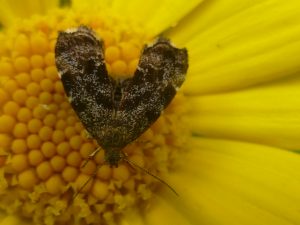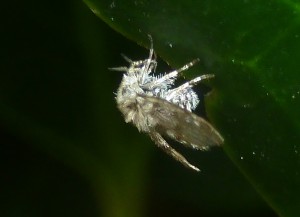Moth fly, Pericoma fuliginosa
September 2014 was mostly dry and warm but there was a week-long period in the middle of the month when it was very damp, dull and misty. Six more species were added to the Garden’s list during the month, bringing it up from 721 to 727. Four of them were flies, one a bug, and one was Copse Snail.
Butterflies — Four butterfly species were recorded at RBGE in September. By far the most frequently seen was Red Admiral of which many (up to eighteen on 26th!) were seen from 9th to the end of the month. There were two records each of Peacock (11th, 26th) and Green-veined White (11th, 30th) and a single sighting of Comma (25th).
Moths — Nettle-tap was seen on several days but other than that and some leaf-mining species identified from their mines no moths were recorded because the DESS volunteers found jobs elsewhere and ceased their trapping activities in the Garden. We are grateful to them for what proved to be quite a successful recording season.
Other insects – Honey Bees, Buff-tailed Bumblebees, Common Carder Bees and Common Wasps were all active and fairly numerous throughout the month but other bee species were much less frequent or, as in the case of Red-tailed Bumblebee, apparently absent. Eleven species of hoverflies were recorded in September. By far the most commonly seen were the Common Banded Hoverfly, Syrphus ribesii (on 17 days) and the drone fly Eristalis tenax (on 14 days). Marmalade Hoverfly was only recorded once, on 2nd.
September was a good month for bugs, with eleven species recorded (out of a total of 23 for 2014 so far). Birch Shield Bug was seen on numerous occasions, Hawthorn Shield Bug, Forest (Red-legged) Shield Bug and Parent Bug less frequently. Alnetoidea alneti was a new Garden record; as both its genus and species name suggest, it was found on alder. Common Green Capsid was regularly seen on the capitula (‘flower-heads’) of Corn Marigold. The only beetle recorded during the month was Pine Ladybird on three days. A minimum of seven fly species was recorded, four of them being new Garden records. These were two cranefly species Tipula confusa and Tipula fulvipennis, Elgiva cucularia and the tiny ‘moth fly’ Pericoma fuliginosa. Tipula confusa was resting on the bark of a tree; as I was taking several photographs of it, T. fulvipennis with its distinctive reddish abdomen seemed to float down from above but unfortunately the sighting was too brief for a photograph to be taken. A Common Earwig was seen on 16th.
Birds September was another quiet month for birds with only 33 species recorded. In fact, up till a few days before the month’s end only 29 species had been seen, but four were added in the last four recording days: House Martin (25th and 26th), Buzzard (29th), Mistle Thrush and Raven (both on 30th). The onset of autumn was marked by the first sighting of southbound migrating Pink-footed Geese coming down from the Arctic on 12th (and on 30th). By the month’s end there also seemed to be quite a few extra Blackbirds and thrushes, possibly from the continent, but none of the ‘winter thrushes’ had yet arrived. The full list of bird species recorded at the Edinburgh Garden in September was: Blackbird, Black-headed Gull, Blue Tit, Bullfinch, Buzzard, Carrion Crow, Chaffinch, Coal Tit, Dunnock, Feral Pigeon, Goldfinch, Great Spotted Woodpecker, Great Tit, Greenfinch, Grey Heron, Herring Gull, House Martin, Jackdaw, Lesser Black-backed Gull, Long-tailed Tit, Magpie, Mallard, Mistle Thrush, Moorhen, Pink-footed Goose, Raven, Robin, Sparrowhawk, Stock Dove, Tawny Owl, Tree Creeper, Wood Pigeon, Wren.


